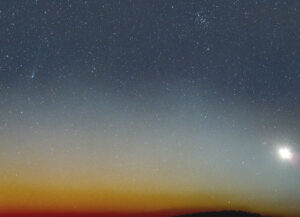Special to CosmicTribune.com, September 11, 2023
Excerpts from weekly Sky&Telescope report.
MONDAY, SEPTEMBER 11
■ You can see in the stars that the season is changing: We’ve reached the time of year when, just as the stars come out, Cassiopeia has climbed as high in the northeast as the Big Dipper has sunk in the northwest. Cas stands high in the northern sky in early evening during the chilly fall-winter half of the year.

TUESDAY, SEPTEMBER 12
■ As dusk turns to night, Arcturus twinkles due west. It’s getting lower every week.
Running upper right from Arcturus is the dimmer, narrow, kite-shaped pattern of its constellation, Boötes.
WEDNESDAY, SEPTEMBER 13
■ Vega now passes the zenith in late twilight, for those of us at mid-northern latitudes. Vega is bigger, hotter, and 50 times brighter than our Sun. But at a distance of 25 light-years it’s 1.6 million times farther away.
THURSDAY, SEPTEMBER 14
■ In the barren region midway between the handle of the Sagittarius Teapot and the bottom of boat-shaped Capricornus lies an asterism of four stars, all by itself. In ancient times Ptolemy cataloged it as the Tetrapleuron, the Quadrilateral. Being so isolated, it was not incorporated into the star pattern of either constellation. Nowadays the group is sometimes known as The Dogs (from a local tradition in southern China about monstrous dog-people in the mountains) or, more recently, as Herman’s Cross, named for the late Maryland amateur astronomer Herman Heyn who rediscovered it and publicized it.
Herman’s Cross is now highest on the meridian after dark. It lies more or less on its side and is about 1° by 2° in size. Its stars are all about magnitude 4½, making it a fine binocular target and visible to the naked eye in a moderately dark sky. It’s such a distinctive little thing that once you know it you’ll spot it often in photos of the Sagittarius Milky Way, demurely off to the east of the main attraction.
Two telescopic globular clusters, M75 and M55, lie a few degrees above and below it. They’re 9th and 7th magnitude, respectively.
■ New Moon (exact at 9:40 p.m. EDT).

FRIDAY, SEPTEMBER 15
■ That 1st-magnitude star high in the south after dark is Altair. To check that you’ve got it, look for its little marker Tarazed, 3rd magnitude, about a finger-width at arm’s length to Altair’s upper right.
Not quite as far straight above Altair is smaller, fainter Sagitta, the Arrow.
SATURDAY, SEPTEMBER 16
■ The closing days of summer (the equinox is coming on the night of September 22-23) always see the Sagittarius Teapot moving west of south during evening.
SUNDAY, SEPTEMBER 17
■ Look very low in the west-southwest during twilight for the waxing crescent Moon. As twilight deepens, can you see Spica twinkling 3° or 4° lower right of it? Use binoculars.
And next, look due west about 25° to the right of the Moon (far below Arcturus) for Comet Nishimura at perihelion! You brought those binoculars, right? You have only a narrow time window between when twilight is still too bright and the comet gets too low and sets.

You must be logged in to post a comment Login